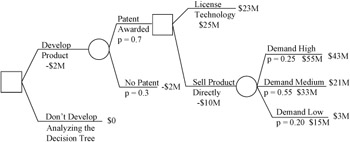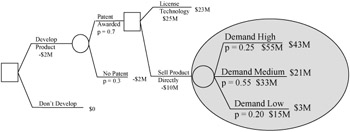Decision Trees
|
A decision tree is a graphical way of representing the various possibilities or choices available in a decision-making process. The key to success in using decision trees is to identify all the possible outcomes. Decision trees also use probabilities in determining the likelihood of one outcome over another, so it is important to have as good a history of event results as possible. Finally, expected value is used to determine the most likely value of a particular branch in the decision tree. Although probabilities will be subjective to a large degree, the use of expected value with decision trees does provide a relative comparison of possible outcomes so that better-informed decisions can be made. Exhibit 7-10 is an example of how the decision tree is developed and used for decision making.
Exhibit 7-10: Research and development decision tree.

The square boxes in the decision tree represent decision points from which various decision paths can be taken. The circles, or nodes, represent points at which various outcomes might occur. In the example, the first decision to be made is whether to even develop the particular product. Not to develop the product could save the company $2 million, which might be the choice if there were other more technically and financially promising products being considered. Assuming the decision was made to pursue the product for the estimated development cost of $2 million, the next decision is dependent upon whether the company can obtain a patent for the product. The probability of obtaining the patent is 70 percent, but there is likewise a 30 percent chance the patent won't be awarded. Without the patent, the project might not be strategically viable and will be stopped. One benefit of the decision tree analysis process is that it provides go/no-go decision points that allow the company to end the project when it is obvious that continuing it would not meet long-term strategic goals.
The figures on the "High, Medium, and Low" branches from the "Sell Product Directly" node are estimates of what the revenues might reasonably be, based on market and competitive analyses. Thus, it is expected that there will be a 25 percent probability that the revenues will be $55 million. The $43 million figure at the end of the branch represents the net revenues that are expected if the "Demand High" branch actually materializes. In other words, when we subtract the $10 million costs for marketing and producing the product and the $2 million development costs from $55 million, the net result is $43 million. The net revenues of $21 million and $3 million for the "Medium" and "Low Demand" branches are determined similarly.
First, analyze the "Sell Product Directly" node. It has been determined that there is a 25 percent probability that the demand will be high for the product; a 55 percent probability there will be a medium demand; and, a 20 percent probability the demand will be low. The fact is, the demand will not be any one of these exactly. Rather, it will be something in between—sort of a weighted average of the three, or, more precisely, the expected value. To determine the expected value of revenues for the "Sell Product Directly" node, highlighted in Exhibit 7-11, we use the expected value formula shown previously and repeated here for convenience.
Exhibit 7-11: Research and development decision tree analysis.

![]()
Thus the EV for the highlighted potential events is:
| EV = 43 .25 + 21 .55 + 3 .20 = 10.75 + 11.55 + .6 | |
| and | EV = $22.9M |
So the expected value of selling the product directly is $22.9 million, which is only $100,000 less than revenues expected from licensing it. The choices to be considered are several. First, since the differences in expected revenues are so little, the conservative approach is to license the product, avoid the hassle of selling and producing the product, and possibly make $100,000 more. But the second, and very important consideration, is that if the company opts to sell the product directly, then it can keep its employees gainfully employed and still make the same amount of money. A third consideration that must not be overlooked is that EV is not the guaranteed amount of revenues that the product will generate—it is the most likely amount. To make a business decision, one has to consider the worst and best cases. In other words, selling the product directly might not generate but $3 million, but it could generate as much as $43 million. So the decision involves also the amount of risk the organization is willing to take. Assuming a strong project management capability, the best decision is to sell the product directly and work toward marketing and managing for a higher demand.
|
EAN: 2147483647
Pages: 129
- Chapter I e-Search: A Conceptual Framework of Online Consumer Behavior
- Chapter III Two Models of Online Patronage: Why Do Consumers Shop on the Internet?
- Chapter VII Objective and Perceived Complexity and Their Impacts on Internet Communication
- Chapter XIII Shopping Agent Web Sites: A Comparative Shopping Environment
- Chapter XV Customer Trust in Online Commerce